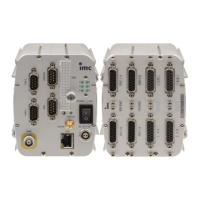© 2018 imc Test & Measurement GmbH
imc C-SERIES - Manual, Version 4 R 3 - 2018-10-19
90 Device description
5.4.1.2 Voltage source without ground reference
The voltage source itself has no reference to unit’s ground, but instead, its potential floats freely vis-à-vis
the device ground. If a ground reference cannot be established, it's also possible to connect the negative
signal input –IN to the ground contact GND.
A voltage source which isn't grounded (e.g. a
battery) and whose contacts have no
connection to ground potential is measured.
The device is grounded.
When –IN and GND are connected, be sure that the signal source's potential can actually be drawn to
the device ground's potential without an appreciable current flowing. If the source can't be brought to
that potential level (because it turns out to be at fixed potential after all), there is a risk of permanent
damage to the amplifier. If IN and GND are connected, a single end measurement is performed. This
isn't a problem unless a ground reference already existed.
5.4.1.3 Voltage source at other, fixed potential
In the input ranges <20 V, the common mode
voltage Ucm must lie within the range ±10 V. It is
reduced by one-half of the input voltage.
5.4.1.4 Voltage measurement: With taring
With voltage measurement, it's possible to tare a zero offset to restore correct zero. For this purpose,
select the menu item Settings -> Amplifiers (balance etc.)…, and on the screen's index card Common,
under Balancing, select the option Tare for the desired channel. The input range correspondingly is
reduced by the amount of the zero adjustment. If the initial offset is so large that it's not possible to
adjust it by means of the device, a larger input range must be set.

